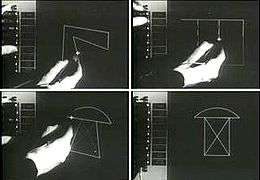Sketchpad
|
Ivan Sutherland demonstrating Sketchpad (UVC via IA: video and thumbnails) | |
| Original author(s) | Ivan E. Sutherland |
|---|---|
| Initial release | 1963 |
| Platform | Lincoln TX-2 |
| Type | animation, drawing, drafting, CAD |
Sketchpad (aka Robot Draftsman) was a revolutionary computer program written by Ivan Sutherland in 1963 in the course of his PhD thesis, for which he received the Turing Award in 1988, and the Kyoto Prize in 2012. It pioneered the way for human–computer interaction (HCI).[1] Sketchpad is considered to be the ancestor of modern computer-aided design (CAD) programs as well as a major breakthrough in the development of computer graphics in general. For example, the graphical user interface (GUI) was derived from the Sketchpad as well as modern object oriented programming. Ivan Sutherland demonstrated with it that computer graphics could be used for both artistic and technical purposes in addition to showing a novel method of human-computer interaction.
History
Sutherland was inspired by the Memex from "As We May Think" by Vannevar Bush. Sketchpad inspired Douglas Engelbart to design and develop oN-Line System at the Augmentation Research Center (ARC) at the Stanford Research Institute (SRI) during the 1960s. Sketchpad was the first program ever to utilize a complete graphical user interface, using an x-y point plotter display and the recently invented light pen. The clever way the program organized its geometric data pioneered the use of "objects" and "instances" in computing and pointed forward to object oriented programming. The main idea was to have master drawings which one could instantiate into many duplicates. If the user changed the master drawing, all the instances would change as well. Another major invention in Sketchpad was that it let the user easily constrain geometric properties in the drawing—for instance, the length of a line or the angle between two lines could be fixed.
As a trade magazine said, clearly Sutherland "broke new ground in 3D computer modeling and visual simulation, the basis for computer graphics and CAD/CAM".[2] Very few programs can be called precedents for his achievements. Patrick J. Hanratty is sometimes called the "father of CAD/CAM"[3] and wrote PRONTO, a numerical control language at General Electric in 1957, and wrote CAD software while working for General Motors beginning in 1961. Sutherland wrote in his thesis that Bolt, Beranek and Newman had a "similar program"[4] and T-Square was developed by Peter Samson and one or more fellow MIT students in 1962, both for the PDP-1.[5]
Hardware
Sketchpad ran on the Lincoln TX-2 (1958) computer at MIT, which had 64k of 36-bit words. Of the 36 bits available to store each display spot in the display file, 20 gave the coordinates of that spot for the display system and the remaining 16 gave the address of the n-component element responsible for adding that spot to display. In 1963 most computers ran jobs in batch job mode only, using punched cards or magnetic tape reels submitted by professional programmers or engineering students. A considerable amount of work was required to make the TX-2 operate in interactive mode with a large CRT screen. When Sutherland had finished with it, it had to be reconverted to run in batch mode again.
Publications
The Sketchpad program was part and parcel of Sutherland's Ph.D. thesis at MIT and peripherally related to the Computer-Aided Design project at that time. Sketchpad: A Man-Machine Graphical Communication System.
See also
References
- ↑ Sears, Andrew; Jacko, Julie A. (19 September 2007). The Human-Computer Interaction Handbook: Fundamentals, Evolving Technologies and Emerging Applications, Second Edition. CRC Press. p. 5. ISBN 978-1-4106-1586-2. Retrieved 1 March 2013.
- ↑ "The CAD/CAM Hall of Fame". American Machinist. Penton Media. November 1, 1998. Retrieved March 18, 2013.
- ↑ "Patrick Hanratty spotlight". The Regents of the University of California. October 18, 2012. Retrieved March 17, 2013.
- ↑ Sutherland, Ivan Edward (January 1963). "Sketchpad: A man-machine graphical communication system (courtesy Computer Laboratory, University of Cambridge UCAM-CL-TR-574 September 2003)". Massachusetts Institute of Technology. Retrieved 2006-12-26.
- ↑ Computer History Museum (15 May 2006). "The Mouse that Roared: PDP-1 Celebration Event (Running Time: 01:53:46)". Retrieved 2013-03-14.
Bibliography
- Coons, Steven (1964), "Computer Sketchpad", in Fitch, John, Science Reporter (episode), explains the principles of "Sketchpad".
- Kay, Alan, "Pt 1", Doing with Images Makes Symbols (video presentation), Archive, 4min5.
- Müller-Prove, Matthias, Graphical User Interface of Sketchpad, DE: MProve.
- Sutherland, Ivan Edward (1980), Sketchpad: A Man-Machine Graphical Communication System, New York: Garland Publishers, ISBN 0-8240-4411-8.
- ———, Sketchpad: A man-machine graphical communication system (PDF) (PhD thesis), UK: CAM.
- ———, "Sketchpad: A Man-Machine Graphical Communication System", AFIPS conference proceedings (paper), PL: ACI.
- Yares, Evan (February 2013). "50 Years of CAD". Design World: 66-71.
External links
|
|
- ——— (30 January 1963), Sketchpad: A Man-Machine Graphical Communication System (PDF), Lincoln Laboratory, Massachusetts Institute of Technology via Defense Technical Information Center, Technical Report No. 296, Archived from the original on April 8, 2013, retrieved 2007-11-03.
- "Sketchpad", Youtube, Google.
